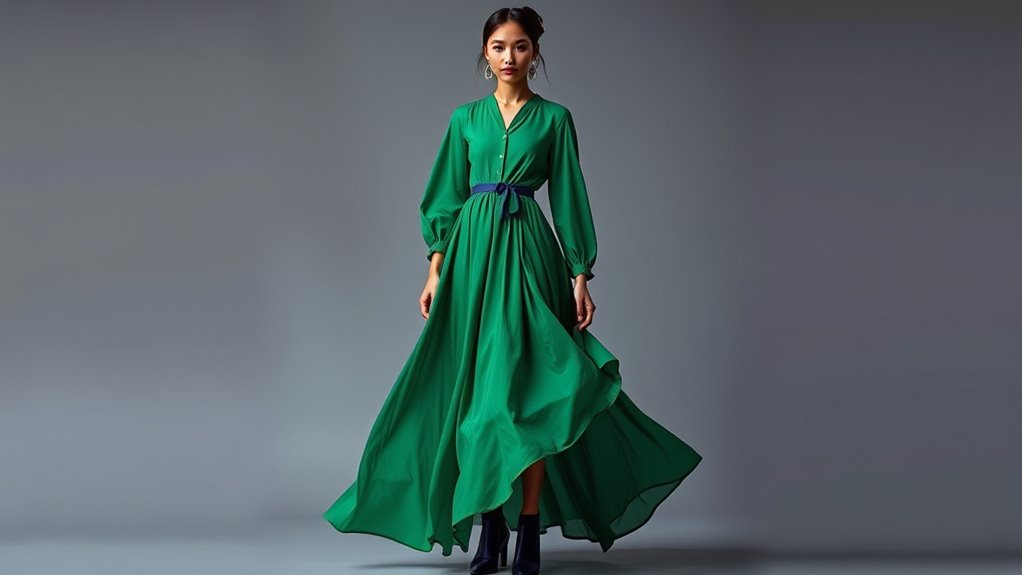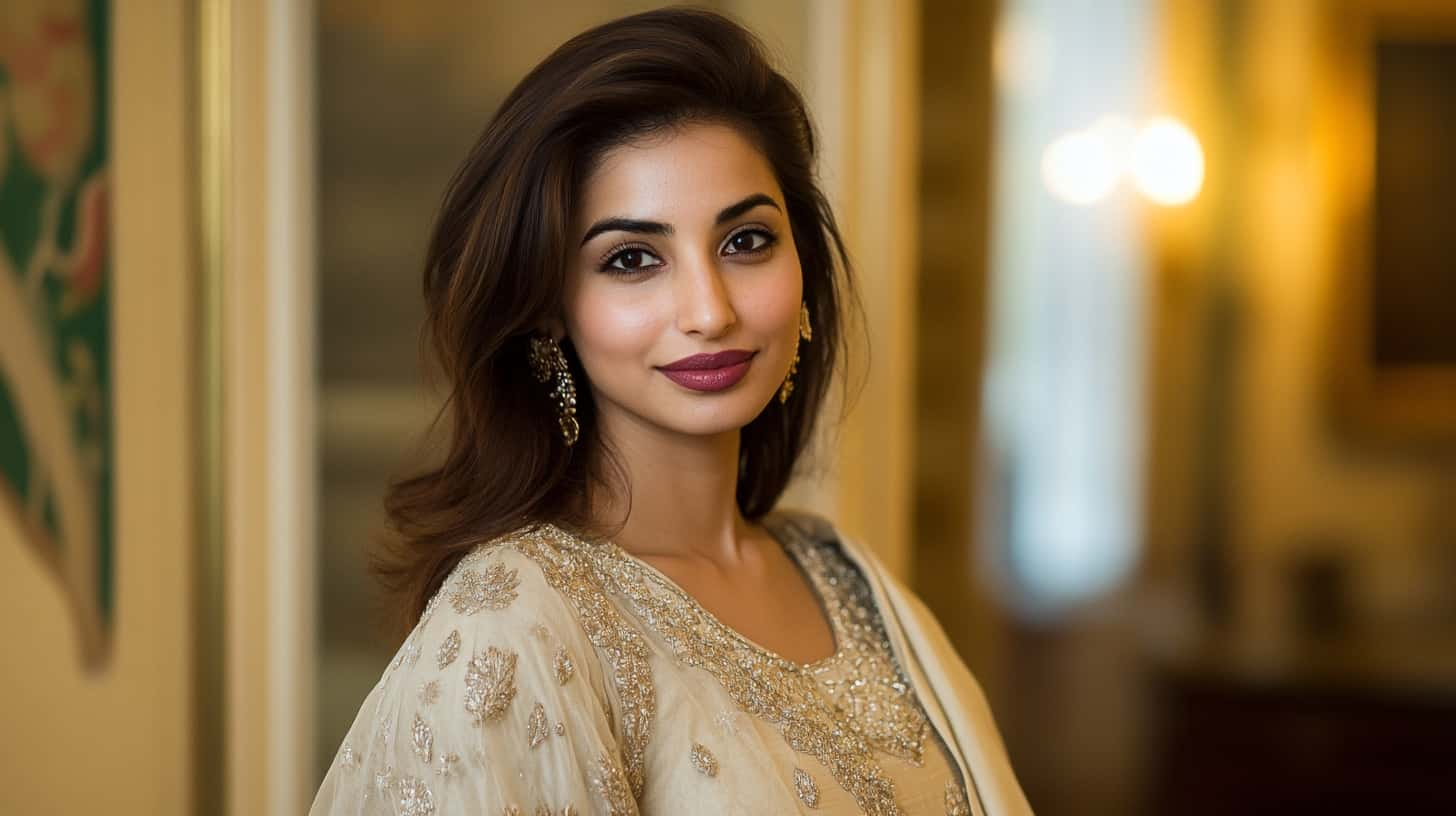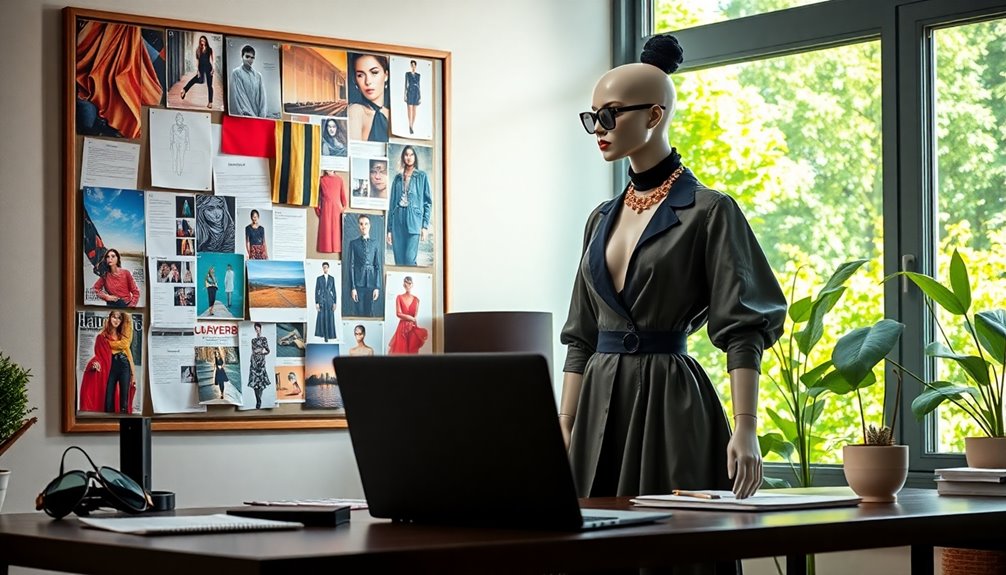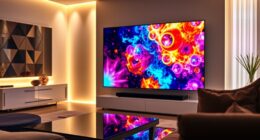Color theory in fashion styling helps you create balanced, eye-catching outfits by understanding color relationships like complementary and analogous schemes. Using these principles, you can express moods and messages—such as confidence or calmness—through color choices. Knowing how colors symbolize different feelings allows you to craft looks for any occasion with purpose and style. Want to explore how to apply these concepts to your wardrobe? Keep going to discover more tips.
Key Takeaways
- Color theory guides fashion styling by using complementary and analogous schemes to create balanced, visually appealing outfits.
- Understanding color symbolism helps convey specific moods or messages through clothing choices.
- Combining color harmony with personal style enhances self-expression and emotional impact in fashion.
- Knowledge of color relationships aids in selecting shades that complement skin tones and enhance overall look.
- Applying color theory principles ensures outfits are stylish, intentional, and suitable for various occasions.
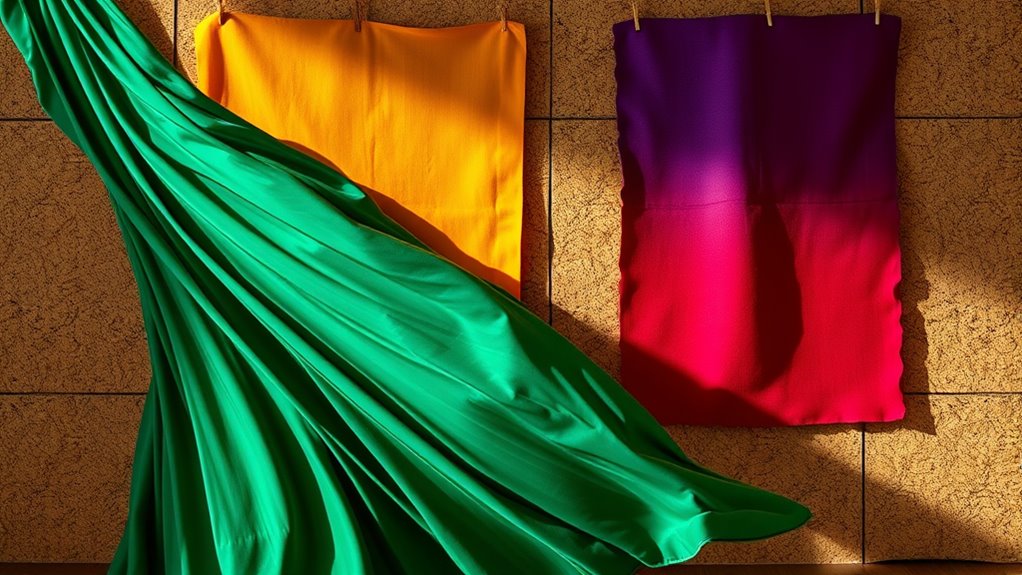
Have you ever wondered how stylists choose the perfect colors to make an outfit pop? It’s not just about picking shades you like; it’s about understanding how colors work together to create a balanced, eye-catching look. This is where the concepts of color harmony and color symbolism come into play. When you grasp these ideas, you gain the power to craft outfits that not only look good but also convey specific moods or messages.
Color harmony is about creating a pleasing visual balance. Think of it as the art of combining colors in a way that feels natural and appealing to the eye. You can achieve harmony through established schemes like complementary colors—those opposite each other on the color wheel, such as blue and orange—or analogous colors, which sit next to each other, like yellow and orange. By understanding these relationships, you can select combinations that make your outfit stand out without clashing. For example, pairing a deep green with a muted purple can produce a sophisticated and harmonious look because these hues are next to each other, creating a smooth link. Conversely, using contrasting colors like red and green can create a bold, energetic statement if balanced well. Knowing how to leverage color harmony helps you make intentional choices, guaranteeing your outfit draws attention without feeling chaotic.
Color symbolism is equally important because colors carry meanings that influence perception. When you select colors thoughtfully, you’re not just choosing shades—you’re communicating. For instance, red often symbolizes passion, energy, or urgency, making it perfect for a statement piece that demands attention. Blue conveys calmness and reliability, ideal for professional settings or outfits that aim for a trustworthy vibe. Yellow radiates optimism and happiness, which can brighten a dull day or create a cheerful appearance. By understanding these associations, you can tailor your wardrobe to reflect your mood or message. If you want to exude confidence, you might lean toward bold reds or regal purples. For a more relaxed, approachable look, soft pastels or earth tones work well. When you use color symbolism intentionally, your outfit becomes more than just fashionable—it becomes a form of self-expression.
Additionally, understanding color science helps you select shades that complement your personal skin tone, enhancing your overall appearance and confidence. Bringing together color harmony and symbolism empowers you to craft outfits that are visually appealing and emotionally resonant. You don’t have to be a professional stylist to understand these principles; with a little practice, you can start applying them to your everyday wardrobe. Whether you’re dressing for a date, a job interview, or just a casual day out, knowing how to combine colors thoughtfully ensures you look confident and intentional. Ultimately, mastering color theory in fashion styling transforms your approach from random selections to deliberate, impactful choices that elevate your personal style.
Frequently Asked Questions
How Do Color Combinations Affect Mood and Perception?
Color combinations directly influence your mood and perception through color psychology and color harmony. Bright, warm hues like red and yellow energize you, boosting confidence, while cool shades like blue and green promote calmness and trust. When you choose harmonious colors, your outfit feels balanced and appealing, enhancing your overall presence. By understanding these effects, you can craft looks that evoke specific feelings and positively shape how others perceive you.
What Are the Best Colors for Different Skin Tones?
For your skin tone, choose colors that create skin tone harmony, enhancing your natural glow. Warm skin tones look great in earthy hues like terracotta, olive, and warm reds, while cool tones shine in jewel tones like emerald, sapphire, and icy blues. Use color matching techniques to complement your undertones, ensuring your outfit highlights your features. Experiment with shades that make you feel confident and comfortable, always keeping your skin tone in mind.
How Can I Incorporate Color Trends Into Everyday Fashion?
Like adding sprinkles to a cupcake, incorporating color trends into your everyday fashion makes it exciting. You can do this by updating your wardrobe with seasonal palettes, which keep your look fresh and relevant. Pair bold colors with neutral accessories to balance your outfit. Experiment with accessory pairing to highlight trendy hues without overdoing it. This way, you stay stylish while blending in current color trends effortlessly.
What Role Does Cultural Significance Play in Color Choices?
Cultural significance influences your color choices by guiding you through cultural symbolism and historical color meanings. You can use this knowledge to express respect, celebrate traditions, or make a powerful statement. For example, understanding that red symbolizes luck in Chinese culture or white signifies mourning in some Western societies helps you make thoughtful, meaningful fashion choices. This awareness enriches your style and connects you to diverse cultural narratives.
How Do Lighting Conditions Impact Color Appearance in Fashion?
Lighting conditions critically impact how colors appear in fashion. You notice lighting effects that can make vibrant hues look dull or cause subtle shades to pop. Shadow play adds depth, altering color perception across different angles and environments. When styling, always consider the lighting environment—natural light enhances true colors, while artificial lighting can shift tones, so test your outfits under various conditions to guarantee your chosen colors look as intended.
Conclusion
Mastering color theory in fashion styling transforms you into an unstoppable force of style. When you confidently wield color like a painter with a palette, you hold the power to command attention, evoke emotions, and shape perceptions. Your wardrobe becomes your battlefield, and every hue an unstoppable weapon. Embrace this knowledge fiercely, and watch as the world reacts to your every move—because with color, you don’t just dress; you dominate.
